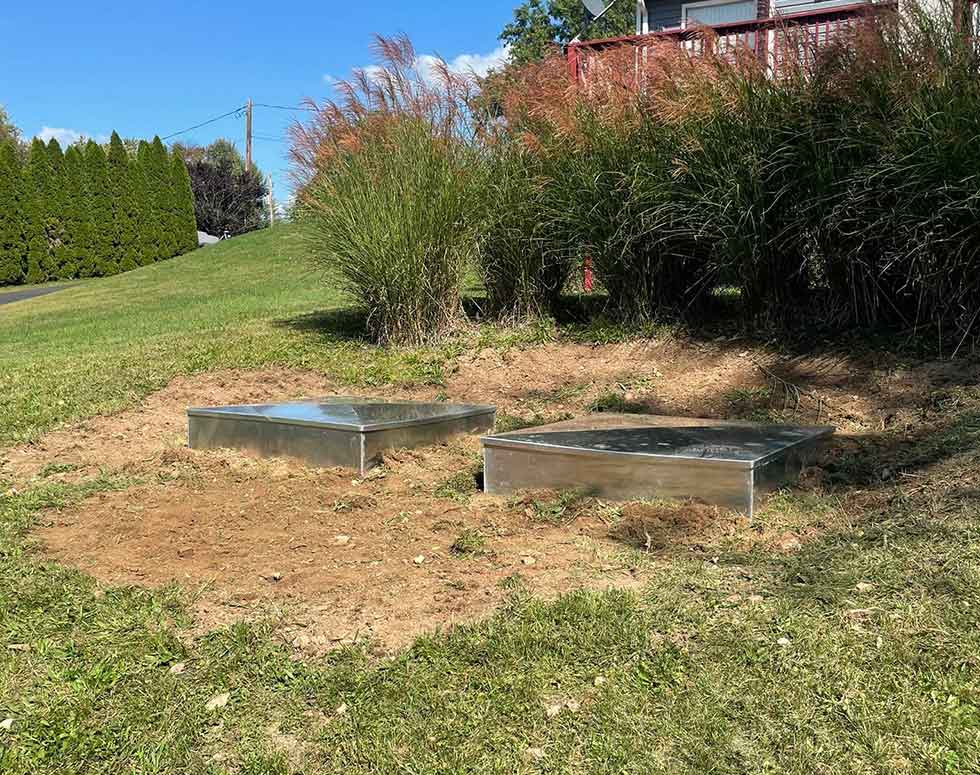Your septic system plays a crucial role in managing your household’s wastewater, and the drainfield, also known as the leach field or absorption field, is an essential component. The health of your drainfield directly impacts the effectiveness of your septic system and your home’s sanitation.
The septic drainfield is the most expensive component of your septic tank drainage system. It also has the biggest influence on the life expectancy of your septic system and it’s the costliest septic system repair if it fails.
Proper maintenance and care are vital to avoiding issues with your septic tank’s drainfield. Being mindful of what enters your septic system — from the amount of water to the type of waste — can help prevent malfunctions and ensure that your system remains functional and effective in treating your household wastewater.

Drainfield Basics
Your drainfield is a network of perforated pipes laid in gravel trenches or beds in unsaturated soil. Wastewater from your septic tank flows into these pipes and exits through the perforations, where it percolates into the soil, further treating and dispersing it. (Learn more about how septic systems work here.)
Pay attention to the following signs; they may indicate that your drainfield is failing:
- Standing water in your yard indicates that effluent (wastewater) isn’t percolating properly.
- Foul odors around the drainfield area suggest untreated wastewater is surfacing.
- Slow drainage or gurgling sounds from toilets and sinks can signal backups.
- Lush vegetation over the drainfield may be due to excess nutrients from effluent.
Common Causes of Drainfield Failure
A drainfield can fail for several reasons:
- Aging: Over time, the ability of the soil to absorb water can decrease, leading to failure.
- Harsh chemicals: Bleach, ammonia, phosphates and petroleum-based chemicals are among chemicals that can kill beneficial bacteria in the septic system and lead to clogs.
- Tree roots: Can invade and damage the perforated pipes.
- Soil compaction: Caused by vehicles or heavy equipment, affects soil’s absorption.
- Non-biodegradable items: Should not be flushed down because they cause clogs.
- Excessive water usage: Can flood the system and prevent proper filtration.
- Failure of septic tank pumps, septic filters and septic tank aerators. When this occurs it allows septic tank sludge to escape from the tank and overload the drainfield with solids, upsetting the biological balance of the system.
Maintaining a Healthy Septic System
To ensure your septic system remains functional and extends its life, it’s important to schedule routine inspections and maintenance, conduct preventive care and repair any problems in a timely manner.
Routine Inspections and Maintenance
Your septic system requires regular maintenance and inspections to prevent malfunctions and potential sewage backup. It’s essential that you have your system inspected by professionals at least every three years or as recommended by your septic services provider. These inspections can identify issues such as clogged pipes or the need for septic tank pumping. Periodic pumping, normally every 3-5 years, is a critical element of septic system maintenance to prevent sludge from building up and causing a malfunction or failure.
Water Conservation Is Vital
To maintain a healthy septic system, conserving water is important. Use water efficiently by installing high-efficiency fixtures and repairing leaks promptly. Be mindful of what goes down your drains; avoid harsh chemicals and antibacterial soaps, which can disrupt the microbial balance within the system.
Enzyme additives can be beneficial, as they help in breaking down waste. Ensure you have an effluent filter installed and clean it periodically to keep solids from entering the drainfield. (Read more about keeping your septic system in top condition here.)
Things to Avoid
To keep your system in top working order, be careful of what you wash down the drain or flush down the toilet. Some of the biggest culprits behind septic problems are:
- Flushable wipes
- Coffee grounds
- Fats, oils and grease
- Excessive household chemicals
- Medications
Troubleshooting and Repair
Some of the signs of a failing septic system include flooding in the drainfield area, an unpleasant odor around the septic tank and slow draining within your home. At the first sign of trouble, it’s critical to investigate to prevent a sewage backup.
If repairs are necessary, refer to local regulations to ensure compliance with septic system standards before beginning any work. Excavating the drainfield or replacing components might be required, which can be costly. Your best solution to ensure that the problem is mitigated cost-effectively and according to local regulations is to contact a professional septic system provider.
Cost of Septic Drainfield Repairs
When your septic drainfield encounters problems, the cost for repairs can vary broadly, with many factors influencing the total expense.
- Average Costs: Typically, you can expect drainfield repair to cost between $1,000 and $5,000. Factors such as size, slope, soil type and location are pivotal in determining these costs.
- Replacement Costs: Should a full replacement be necessary, the costs can reach $20,000.
Remember: This is a general guide, and prices can fluctuate based on local rates and specific circumstances of the repair or replacement needed. It’s always advisable to get quotes from trusted professionals in your area to ensure competitive pricing.
